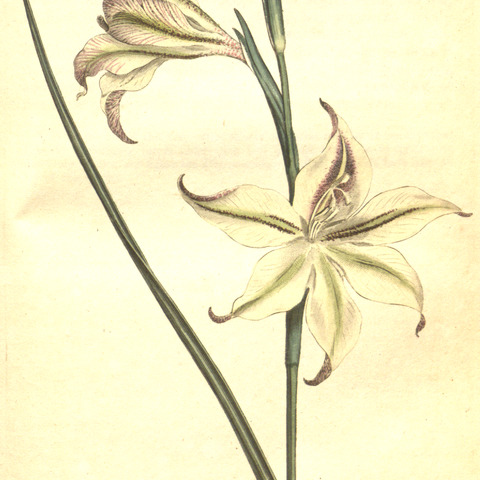Plants 50–90(–150) cm. Corms tunicate, 10–20 mm diam.; tunics ± woody, broken into segments proximally and distally. Stems simple. Leaves 3, basal longest, usually ± reaching middle of stem, sheathing in lower 1/2, distalmost 2 leaves largely to entirely sheathing; blade cruciform in cross section, 2–3 mm diam. Spikes 2–4 (–8)-flowered, secund; sheaths sometimes flushed grayish purple, subequal, 30–40 mm, inner slightly shorter than to ± equaling outer. Flowers strongly scented of carnations and cloves in evening; perianth tube obliquely funnel-shaped, 45–50 mm, narrow cylindrical section ca. 25 mm; tepals white to cream, with darker greenish yellow or purple on midlines, margins transparent in lower 10 mm, especially between dorsal and inner lateral tepals, lanceolate, unequal, dorsal inclined to ± horizontal, 22–25 × 16 mm, outer tepals fused with inner lateral tepals for ca. 2 mm, ± straight and directed forward, or gently curving outward in distal 1/2, ca. 22 × 10 mm; filaments ca. 20 mm, included in tube; anthers ca. 12 mm, partly included in tube; style branching opposite distal 1/3 of anthers; branches ca. 6 mm, reaching beyond anthers. Capsules oblong-ellipsoid, 34–36 mm. Seeds broadly winged, 5 × 4 mm.
Perennial herb, geophyte, 0.45-1.50 m high; corm with firm papery to hard tunic layers; stem erect, flexed above. Leaves 3, terete, centric, imbricate below, 2-4 mm wide; midrib raised. Bracts pale to dark green, sometimes flushed greyish above. Inflorescence a 1-4-flowered spike, lightly inclined; flowers pale yellow to greenish yellow or cream-coloured; tepals darker on midlines or with purple to reddish median streaks, reverse usually dark grey-purple to reddish on midlines; perianth tube narrowly and obliquely funnel-shaped, papillose below; tepals lanceolate, unequal, dorsal largest, inclined to ± horizontal. Stamens included; anthers pale yellow to light purple; pollen pale yellow. Ovary oblong; style arching over stamens, scabridulous below. Flowering time Sept.-Jan. Capsule ± oblong-ellipsoid.
Herb 30-60 cm tall. Corm 1-3 cm diam.; tunic papery to woody. Basal leaf narrowly linear, 30-60 cm long, 2-4 mm wide, rigid, cruciform in section with thickened midvein and margins. Stem unbranched, with 2 or 3 reduced leaves. Spike secund, erect, 2-7-flowered. Bracts oblong, 3-5 cm long. Flowers funnel-shaped, dull yellow; each lobe with a dark stripe, often blackish veined or speckled. Perianth tube slender in lower half, curved and widened above, 4-6 cm long; lobes ovate-elliptic, acute, spreading, 2-3 cm long; dorsal lobe 1.5-2 cm wide, others narrower, the lower 3 shortly connate. Stamens slightly arched; anthers 12-14 mm long. Style branches narrowly obcordate, 4-6 mm long. Fruit not seen.
Cormous geophyte, 40-150 cm, tunics fibrous. Leaves slender, cross-shaped in section. Flowers long-tubed, cream-coloured with brown shading, fragrant in evening.
Cormous geophyte, 400-1500 mm tall, tunics fibrous. Leaves slender, cross-shaped in section. Flowers long-tubed, cream with brown shading, fragrant in evening.

